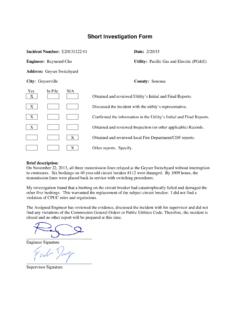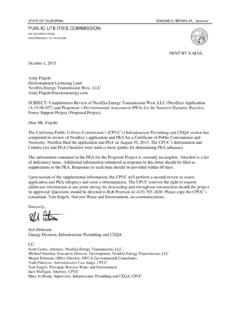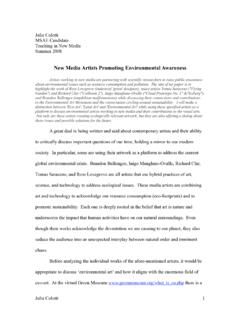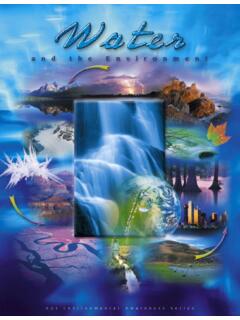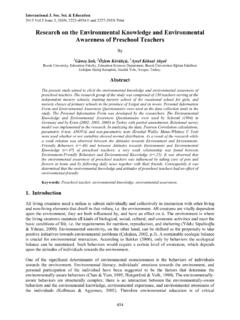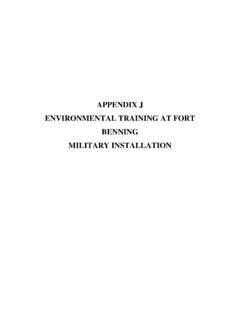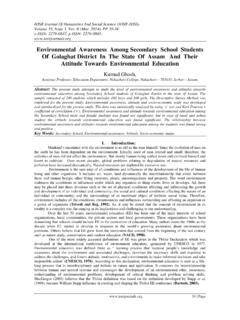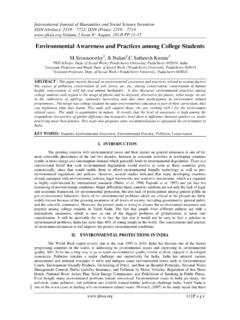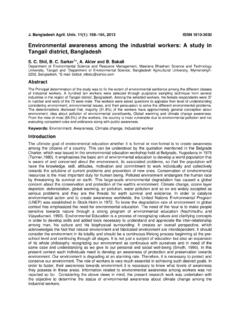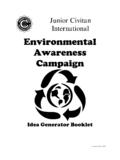Transcription of Worker Environmental Awareness Program (WEAP) West of ...
1 Southern California EdisonWorker Environmental Awareness Program ( weap ) west of Devers (WOD) Upgrade ProjectEnvironmental ResourcesMay 20171 Everyone is responsible for protecting the OutlinePurpose: Inform WOD Personnel of the Regulatory Compliance Requirements and Responsibilities for Conserving Environmental ResourcesCourse Outline: WOD Overview Special-Status Species Conservation Legislation Regulatory Permits Sensitive Species Applicable Mitigation Measures Species Identification Special Status Plants Special Status Wildlife Weed Control Program Compliance Responsibilities Environmental Monitors Construction Personnel Stormwater Pollution Prevention Plan (SWPPP) and Best Management Practices (BMPs) Hazardous Materials and Hazardous Waste Air Quality Fire Management Cultural Resources Paleontological Resources Past Project Pitfalls Contractual Obligations & Protective Requirements Contact InformationEveryone is responsible for protecting the Overview: Project AreaEveryone is responsible for protecting the Overview The WOD project increases the power transfer capability of the WOD 220-kilovolt (kV) transmission lines between Devers, El Casco, Vista, and San Bernardino substations.
2 The lead agencies include the California Public Utilities Commission (CPUC) and the Bureau of Land Management (BLM). The project will be constructed under the following plans and permits: Coachella Valley Multiple Species Habitat Conservation Plan (CV-MSHCP) Western Riverside County Multiple Species Habitat Conservation Plan (WR-MSHCP) Fish and Wildlife Service (USFWS) Biological Opinion California Department of Fish and Wildlife (CDFW) Incidental Take Permit Compliance with biological mitigation measures is a mandatory condition of the CPUC approval. BLM and CPUC project approvals require mitigation measures to protect sensitive species and their habitats. *Noncompliance with mitigation measures can result in project delays or shutdown and violations and penalties, including fines, equipment forfeiture, and is responsible for protecting the Species Conservation Why Conserve Species?How do we benefit from conserving special-status species?
3 Endangered species are of esthetic, ecological, educational, historical, recreational, and scientific value to the nation and its people. Endangered Species Act of 1973 Conserving unique plants and animals and the ecosystems upon which they depend is necessary to conserve our country s biological is responsible for protecting the Species Conservation Legislation California Environmental Quality Act/National Environmental Policy Act Endangered Species Federal Endangered Species Act (FESA) California Endangered Species Act (CESA) Sensitive and Management Indicator Species Migratory Bird Treaty Act Bald and Golden Eagle Protection Act Federal Land Policy and Management Act Wetlands and Waters Federal Clean Water Act (CWA) California Department of Fish and Game (CDFG) Code (Streambed Alteration Program ) Porter-Cologne Water Quality Control Act (PCWQCA) Weeds Federal Plant Protection Act Federal Noxious Weed Control and Eradication Act California Department of Food and Agriculture Code6 Everyone is responsible for protecting the Species Conservation Legislature It is illegal to kill, injure, or otherwise harm Endangered Species or habitats.
4 Take permits are required to incidentally harm Endangered Species Act-protected species or habitats. Noncompliance penalties include fines, equipment forfeiture, and is responsible for protecting the Species Conservation WR-MSHCP and CV-MSHCP Goal:Maintain biological and ecological diversity within a rapidly urbanizing region of Riverside County and the Coachella Valley. WOD is required to comply with the terms of its inclusion in the WR-MSHCP and CV-MSHCP. To the extent feasible, contractors will avoid impacts to covered species ( , Coastal California Gnatcatcher in the WR-MSHCP and desert tortoise in the CV-MSHCP) and their habitats. General BMPs include minimization of impacts to native vegetation, preventing the spread of exotic species, spill prevention, implementation of water pollution and erosion control plans, etc. Specific avoidance, minimization, and mitigation measures may be required if impacts to certain species ( , smooth tarplant and Yucaipa onion in the WR-MSHCP and desert tortoise and burrowing owl in the CV-MSHCP.)
5 BLM and CPUC project approvals require mitigation measures to protect sensitive species and their is responsible for protecting the Measures: Biological Special-Status Species Conservation Biological mitigation measures primarily focus on the conservation of special-status plant and wildlife species and the habitats upon which they depend. Special-Status Species Definition: Listed under FESA or CESA. Designated by an agency as is responsible for protecting the Measures: Wildlife must not be harmed or harassed, regardless of its conservation status. Noncompliance with these measures, regulations, conditions, and laws could result in project delays or shutdown, fines, or : A complete list of all measures, regulations, and conditions is included in an appendix to this is responsible for protecting the Obligations and Protective Requirements The Construction Contractor is responsible for constructing the project in compliance with all Environmental measures and direction provided by field monitors.
6 Environmental monitors will evaluate the Construction Contractor s compliance with and performance of Environmental specifications. The following list summarizes the Construction Contractor s and field monitors general responsibilities: Construction Contractor: Review and understand Environmental measures and specifications. Implement and maintain compliance with Environmental measures and specifications. Respond to all Environmental monitor requests, and adhere to all Environmental monitor directions. Attend the project s weap training before beginning onsite work. Conspicuously delineate boundaries of all work areas prior to mobilization, and discuss Environmental resource issues with an Environmental is responsible for protecting the Obligations and Protective Requirements Provide schedules and describe work activities adequately to schedule monitoring resources. Restrict all activities, vehicles, and equipment to approved/designated work areas and access routes.
7 Limit vehicle and mobile equipment speeds to 15 miles per hour throughout the project right-of-way. Do not bring pets into any project construction site. Establish, operate, and maintain a project-wide trash collection system to securely retain all food and other trash with the following specifications: Receptacles that are self-closing, wind-proof, sealable, and animal proof Regularly inspected and emptied to prevent spillage and maintain sanitary conditions12 Everyone is responsible for protecting the working in the field must be aware of the following Mitigation Measures from the FEIR and FEIS, and Conservation Measures from the Biological Opinion (BO). Contractor personnel will be provided the full list of measures and detailed descriptions in parallel with the Measure /Conservation MeasureMitigation Measure/Conservation Measure DescriptionAir QualityAQ-1a: Minimize fugitive : Control emissions. AQ-1c: Control helicopter emissions.
8 Biological Resources Vegetation VEG-1c: Minimize native vegetation and habitat loss. VEG-1d: Restore or revegetate temporary disturbance areas in accordance with the Habitat Restoration and Revegetation : Control the spread of weeds. VEG-4a: Avoid special-status plants. Biological Resources Wildlife WIL-1b: Minimize impacts to wildlife species. WIL-1c: Comply with the Nesting Bird Management : Minimize impacts to desert tortoises. WIL-2b: Throw all trash and food trash in containers that have lids, and ensure all garbage containers are closed at all times. WIL-2d: Exclusionary fence or other measures to avoid Stephens' kangaroo rat should be : Minimize impacts to golden eagles if a nest is observed within 2 miles of the project site by implementing a 1-mile buffer. WIL-2g: Avoid burrowing owls and burrows. WIL-2h: Minimize impacts to special-status terrestrial : Minimize impacts to the American badger, ringtail, and desert kit is responsible for protecting the working in the field must be aware of the following Mitigation Measures from the FEIR and FEIS, and Conservation Measures from the BO.
9 Contractor personnel will be provided the full list of measures and detailed descriptions in parallel with the Measure/Conservation MeasureMitigation Measure/Conservation Measure DescriptionCultural Resources CL-1a: Avoid environmentally sensitive areas. CL-2a: Construction will be halted if cultural resources are identified. Hazards & Hazardous Materials HH-3a: Identify pesticide/herbicide contamination. NoiseN-1a: Implement best management practices for construction : Minimize helicopter noise. Paleontological Resources PAL-1d: Avoid paleontological resources. Recreation R-1c: Provide a temporary detour for Pacific Crest National Scenic Trail users. Transportation & Traffic T-1c: Restrict lane closures. T-1e: Ensure pedestrian and bicycle circulation and safety. T-1f: Provide access to property. T-4a: Repair roadways damaged by construction activities. Utilities and Public Services UPS-1a: Use non-potable water for construction purposes.
10 Visual Resources VR-1a: Screen construction activities from view. VR-2a: Minimize vegetation removal and ground disturbance. VR-4a: Minimize in-line views of retaining walls and land scars. VR-5a: Prohibit construction marking of natural features. VR-7a: Minimize night lighting at project facilities. Everyone is responsible for protecting the working in the field must be aware of the following Mitigation Measures from the FEIR and FEIS, and Conservation Measures from the BO. Contractor personnel will be provided the full list of measures and detailed descriptions in parallel with the MeasureConservation Measure DescriptionConservation MeasuresCM 3:Access to sites will be via pre-existing access routes to the greatest extent possible. CM 4:Limit activities, vehicles, equipment, and construction materials to the designated staging areas and routes of 5:Do not bring pets or firearms into the action area. CM 6:Comply with project speed limits.


